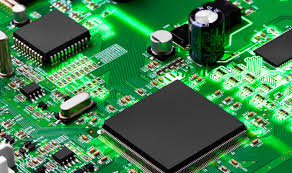1. Single sided PCB board
The substrate materials are mainly phenol copper sheet laminate (phenol as the base, copper foil on the top) and epoxy copper sheet laminate. Most of them are used in home appliances such as radios, AV appliances, heaters, cold stores, washing machines, and commercial machines such as printers, vending machines, circuit machines, and electronic components, with the advantage of low prices.

2. Double sided PCB
The substrate materials are mainly Glass Epoxy copper laminate, GlassComposite (glass composite) copper laminate and paper Epoxy copper laminate. Most of them are used in personal computers, electronic musical instruments, multi-functional telephones, electronic machines for automobiles, electronic peripherals, electronic toys, etc. As for the glass benzene resin copper laminate, the glass polymer copper laminate is mostly used in communication machines, satellite broadcasting machines and mobile communication machines due to its excellent high-frequency characteristics. Of course, the cost is also high.
3. 3-4 layer Multilayer PCB
The substrate material is mainly Glass Epoxy or benzene resin. It is mainly used for personal computers, Me (Medical Electronics) machines, measuring machines, semiconductor testing machines, NC (Numeric Control) machines, electronic exchanges, communication machines, memory circuit boards, IC cards, etc. There are also glass composite copper laminated boards as multilayer PCB materials, mainly focusing on their excellent processing characteristics.
4. 6-8 layer PCB
The substrate material is still mainly Glass Epoxy or Glass benzene resin. Used for electronic switches, semiconductor testing machines, medium-sized personal computers, EWS (Engineering Work Station), NC and other machines.
5. PCB with more than 10 layers
The substrate is mainly made of glass benzene resin, or glass epoxy is used as the multilayer PCB substrate material. This kind of PCB has special applications, most of which are large computers, high-speed computers, communication machines, etc., mainly because it has high frequency PCB characteristics and high temperature characteristics.
6. Other PCB substrate materials
Other PCB substrate materials include aluminum substrate, iron substrate, etc. The circuit is formed on the base plate, and most of it is used on the rotary machine (small motor) car. In addition, there is a flexible PCB. Circuits are formed on materials such as polymers and polyesters, which can be used as single layer, double layer, or multi layer boards. This kind of flexible circuit board is mainly applied to the movable parts of cameras, OA machines, etc., as well as the connection between the above-mentioned hard PCB or the effective connection combination between the hard PCB and the soft PCBs. As for the connection combination mode, due to its high elasticity, its shape is diversified.
7. What are the PCB dry films
1) When arranging components, temperature sensitive devices other than temperature detection devices should be placed close to the air inlet, and at the upstream of the air duct of components with high power and heat, as far as possible away from components with high heat to avoid the impact of radiation. If they cannot be far away, they can also be separated by thermal shielding plates (polished metal sheets, the smaller the blackness, the better).
2) Place the heating and heat-resistant device close to the air outlet or on the top, but if it can not withstand higher temperature, it should also be placed near the air inlet. Pay attention to stagger the position with other heating devices and thermal sensors in the direction of air rise.
3) High power components shall be distributed as far as possible to avoid concentrated heat sources; Components of different sizes shall be arranged evenly as far as possible to ensure uniform distribution of wind resistance and air volume.
4) The vent shall be aligned with the components with high heat dissipation requirements.
5) The high components are placed behind the low components and arranged along the direction with the minimum wind resistance in the long direction to prevent the air duct from being blocked.
6) The radiator configuration shall facilitate the circulation of heat exchange air in the cabinet. In case of natural convection heat transfer, the length direction of the radiating fin shall be perpendicular to the ground. When forced air is used for heat dissipation, the same direction as the airflow direction shall be adopted.
7) In the direction of air flow, it is not suitable to arrange multiple radiators in a vertical close distance. As the upstream radiator separates the air flow, the surface wind speed of the downstream radiator will be very low. The fins shall be staggered or staggered.
8) The radiator shall have a suitable distance from other components on the same circuit board. Through thermal radiation calculation, it is appropriate to avoid inappropriate temperature rise.
9) Use PCB for heat dissipation. If the heat is distributed through a large area of copper (resistance welding window can be considered), or the ground connection via is led to the plane layer of the PCB board, the whole PCB board is used for heat dissipation.